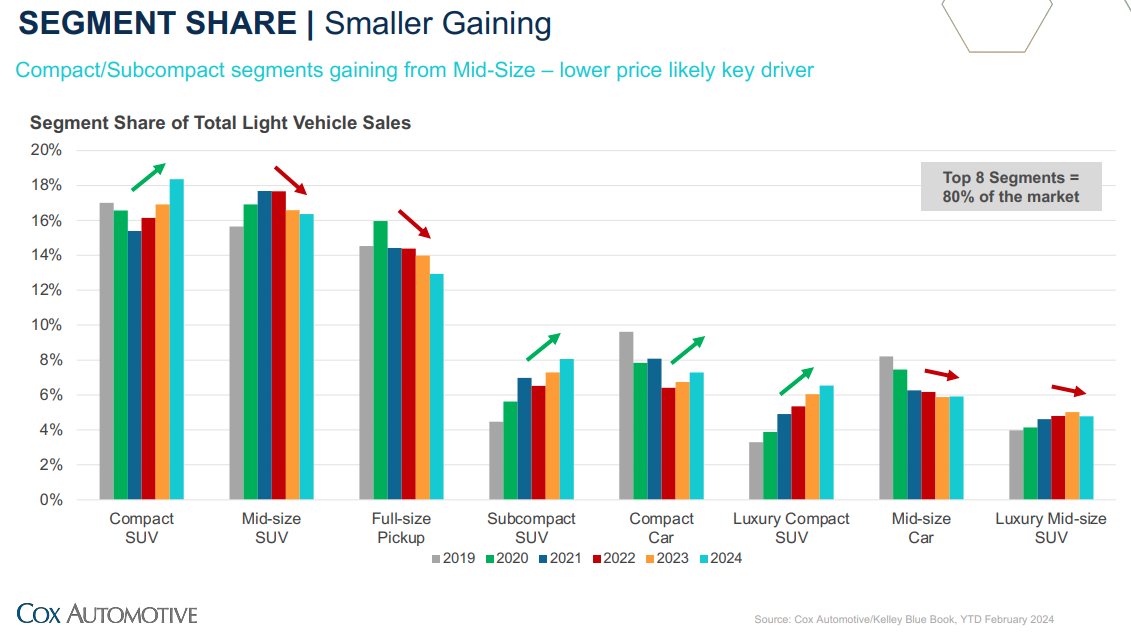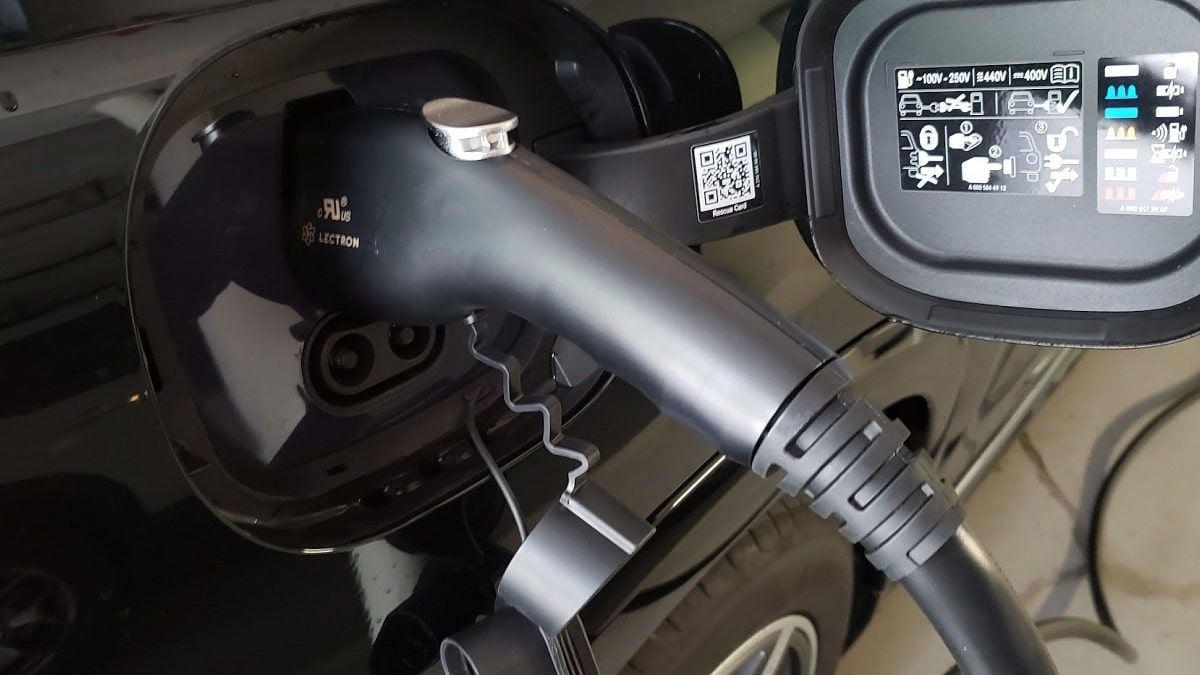Electric vehicles in 2024 take many shapes, sizes, and can handle many duties. However, not a single one of them hits the largest target in the American vehicle market. That’s because the largest volume of vehicles sold in America land in this segment:
-Five passengers
-Crossover SUV style
-Compact or subcompact (the two are merging into one large segment)
-All wheel drive
-Mid-trim priced between $30K and $36K, or $33K to pick an average of those two.
This segment is made up of the Toyota RAV4, Honda CR-V, and Subaru Forester on the larger side and the Toyota Corolla Cross, Honda HR-V, and Subaru Crossstrek on the smaller side of the segment. Combined, these types of vehicles are larger than the U.S. truck market and dramatically larger than the sedan or large SUV market.
So, if electric vehicles are to take over the U.S. market and win the hearts, minds, and wallets of American shoppers, why haven’t any manufacturers, including Tesla, built an EV for this market? After all, Toyota was shipping all-electric FWD RAV4s back in 1997 and has had four generations of plug-in vehicles since then.
 The $30K to $36K Crossover SUV - What Is It?
The $30K to $36K Crossover SUV - What Is It?
We turned to Kelley Blue Book by Cox Automotive for some data on the largest markets in America. This organization provides outstanding data on the average transaction price (ATP) of each type of vehicle, and each brand’s ATP on a monthly basis. These data sets are an invaluable resource to help one understand the actual prices being paid by consumers, as opposed to advertised “Entry MSRPs,” which are dramatically lower for a given vehicle or given vehicle segment.
According to Kelley Blue Book by Cox Automotive, the Compact SUV/Crossover segment had a $35,945 ATP in February. These are the RAV4s, CR-Vs, Mazda CX-5s, and other similarly-sized vehicles so popular with American families. The Subcompact SUV/Crossover segment has an average ATP of $30,082. These are the Toyota Corolla Cross, Honda HR-V, Hyundai Kona, and Subaru Crosstrek, which are the vehicles many young buyers and married couples purchase. The compact segment itself rivals the truck market in America in terms of volume of vehicles shipped to private buyers.
Where Are the Electric Vehicles In America’s Largest Vehicle Segments?
If you examine the United States’ vehicle market offerings closely, you will find that there are not now, nor have there been in the past, any battery-electric, all-wheel drive crossover SUVs within the ATP range of $36K to $33K, nor are any planned.
Why AWD Matters
If you live in a sunny climate, you may be asking, “Who cares about AWD?” This is a valid question, and it has a valid answer. The answer is pretty much every buyer who lives above the Mason Dixon line. Most manufacturers will not send any two-wheel drive crossover inventory to dealers in wintery climates. The reason is they won't sell well. Mazda and Subaru simply don't bother to build any 2WD vehicle in these segments. Toyota markets itself as the brand with the most AWD vehicles. This is a very important feature that many buyers simply either need or want and choose when given a choice. For many, it is a must-have.
Why Automakers Cannot Build a Battery-Electric $33K AWD Crossover
Battery cost is the simple answer as to why automakers have never built an affordable mainstream all-wheel drive crossover BEV. Since the battery cost is so high, the automakers cannot include a second set of drive motors and powertrain components for a second end of the vehicle. It breaks the budget. Sure, automakers can give the electric vehicle away at a loss, and most already do so. But there is a limit to how much money a company can burn. Since these segments are massive, automakers cannot sell the type of vehicle Americans want most in an electric form and stay afloat, even with massive federal and state EV subsidies.
Examples of Least Expensive AWD Crossover SUV BEVs
Here are examples of popular manufacturers and their least expensive all-wheel drive crossover SUV battery-electric vehicles.
1) Tesla: We looked to Tesla, the American-market leader in battery-electric powertrain-equipped vehicles, to see how close the brand comes to making an AWD $33K mid-trim crossover SUV. We started with the brand’s least expensive model that fits that description. Here is the price breakdown according to the Tesla configurator on March 25, 2024:
Model Y LR AWD
$48,990 MRP
$1,390 Destination fee
Total Price $50,380
2) Ford: Ford Mustang Mach-E Select e-AWD
$42,895 MSRP
$1,800 Destination Charges
Total Price $44,695
3) Hyundai: Hyundai is doing great with many new models: Hyundai Ioniq 5 SEL AWD
$50,900 MSRP
$1,375 Freight
Total Price $52,275
4) Toyota: We would expect Toyota to come closest, but Ford was less expensive: Toyota bZ4X
$45,150 MSRP
$1,350 Delivery Processing and Handling
Total Price $46,500
As you can see, none of the manufacturers on our list of examples has created a $36K to $33K mid-trim all-wheel drive crossover with a battery-electric powertrain. Ford came closest with its Mustang Mach-e, which is actually a car, but we felt we could include it in the story anyway.
Battery-electric vehicles enjoy massive government subsidies at the back end. That is the behind-the-scenes subsidies in the form of mandated ZEV credits to meet emissions rules. Many enjoy consumer-facing subsidies in the form of federal income tax incentives or state rebates. However, on the flip side, many consumers are disqualified for being too hard-working and too successful (they make too much money), or they are new to the workforce or retired, and the tax incentives are not applicable to them. Sweetheart leases abound, but that is true of vehicles with all types of powertrains.
What About Electric Pickup Trucks?
The truck market in America is truly huge. However, much of the truck “sales” data you see reported groups together all sizes of trucks. For example, Ford may group the entire F-Series of models into one "model" to brag about a massive total number. It makes one think of the F-150, but numerous other models are in that total (F-250, F-350, F-450, F-550). Also, in America, there are three truck markets, and they are all reported as "Sales" by automakers. Fleets, commercial sales, and personal use make up these three individual markets. While crossovers certainly do enjoy some fleet sales, the truck market is unusual in that a very large percentage of the vehicles delivered by manufacturers are not for personal use. Rather, companies large and small purchase them, municipalities buy them, and law enforcement purchases them.
It’s fantastic that automakers have started to build battery-electric trucks. However, the numbers are miniscule. Tiny. So small that some automakers won’t even tell the media how many they delivered. Rivian has declined our requests to provide sales data on multiple occasions. That will change (hopefully). At some future point, we expect battery-electric trucks to make up a meaningful portion of vehicle sales in America. Today, the delivery volumes are insignificant.
What About the Volvo EX-30 and Chevrolet Equinox EV?
Two new EVs that have yet to be launched show great promise. Both Chevrolet and Volvo are planning to introduce a new compact / subcompact crossover SUV with a battery-electric powertrain. Both have offered up an approximate $35K starting price point to any journalist willing to hype the price of these two vehicles. However, that is the entry price (proposed) and does not represent an all-wheel drive variant, which would cost much more. Also, the average transaction price and entry-level price of a given vehicle are very different numbers. It remains to be seen if these models are actually launched in America and, if they are, what prices they will be delivered at.
Everyone Wants EVs to Succeed
One reason that EVs get so much attention is that everyone has a stake in their success. The federal government, under President Biden, is all-in on EVs. California, which is the de facto governing agency for auto emissions in America, has been pro-EV for decades. Many consumers want EVs, and others wish for them to succeed. Many publications masquerading as media outlets are dedicated to promoting battery-electric vehicles. With so much support for EVs, it is no surprise that there is a lot of hype around delivery volumes and new advances in the state of the art of EVs.
Despite the best wishes of much of the auto industry and the governments in America, no automaker is selling, or about to sell, the most popular type of vehicle in the country with a battery-electric powertrain. When that changes, we will be the first to highlight this momentous event.
Image of Lectron charger handle by John Goreham. Chart of market segments courtesy of Kelley Blue Book by Cox Automotive.
John Goreham is an experienced New England Motor Press Association member and expert vehicle tester. John completed an engineering program with a focus on electric vehicles, followed by two decades of work in high-tech, biopharma, and the automotive supply chain before becoming a news contributor. In addition to his eleven years of work at Torque News, John has published thousands of articles and reviews at American news outlets. He is known for offering unfiltered opinions on vehicle topics. You can follow John on Twitter, and connect with him at Linkedin.






Comments
I think Rivian with the R2,…
Permalink
I think Rivian with the R2, R3, and R3X has best addressed the market segments you’re talking about, as well as exemplifies the building at a loss with their current vehicles. The R2 can’t come soon enough. With 1 EV in the driveway I have been searching for another that can match the utility and capabilities of my Outback, and I would bet many people like me are going to make the EV market look poor while we wait on Rivian.